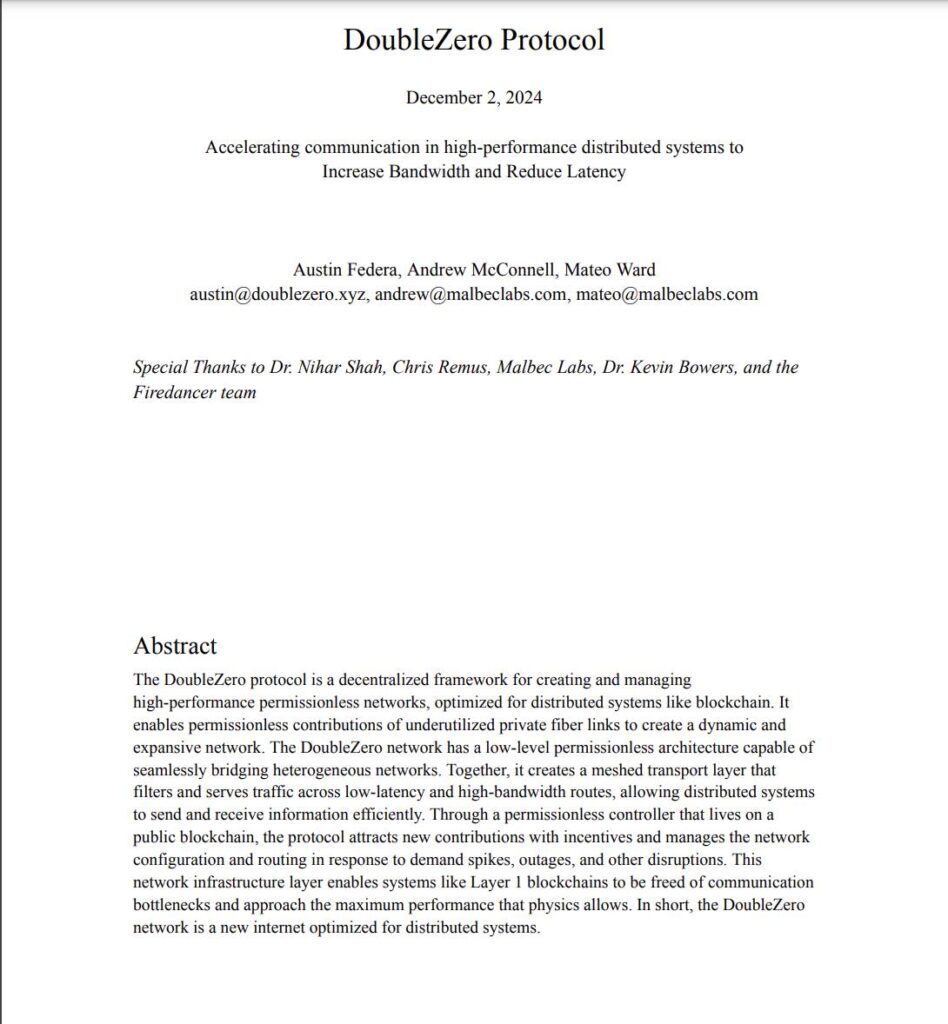The cryptocurrency landscape is buzzing with excitement as the DoubleZero Protocol gears up for a significant leap forward in blockchain infrastructure. This pioneering network is set to enhance the speeds and efficiencies of distributed systems, all while preparing for its upcoming validator funding round. This momentous occasion marks the first public token sale in the United States since 2019, and it will take place from April 2 to April 10 on the CoinList platform.
Exclusively available for accredited investors, this funding round presents a unique opportunity for current validators in esteemed networks like Solana, Celestia, Sui, Aptos, and Avalanche. Interested parties can submit bids indicating their preferred token prices and overall budgets, all of which will be used to determine the final sale price for these validators. As the co-founder of the DoubleZero Protocol, Austin Federa, expressed, this sale is a groundbreaking chance for those already securing some of the most advanced blockchains.
“This industry has seen huge investment and innovation at the top of the stack—it is time to revolutionize the physical infrastructure layer powering high-performance distributed systems,” said Federa.
The timing seems ripe for innovation, as recent reports indicate a surge in capital fundraising within the crypto space, suggesting a promising outlook for market growth through 2025. Following a successful $28 million funding round led by notable venture firms, including Multicoin Capital and Dragonfly Capital, DoubleZero has set its sights on launching its mainnet in the latter half of 2025.
What sets the DoubleZero Protocol apart is its commitment to utilizing a dedicated fiber optic network to ensure high-speed and low-latency connectivity for blockchains. This technological advancement can be likened to the transition from slower dial-up connections to the rapid pace of broadband internet in the early 2000s, highlighting the potential impact this protocol might have on the cryptocurrency ecosystem.
As the DoubleZero Protocol prepares for this pivotal funding round, all eyes will be on its innovative approach aimed at revitalizing blockchain infrastructure and setting the stage for the next wave of distributed systems in the rapidly evolving crypto industry.
The DoubleZero Protocol: Transforming Blockchain Infrastructure
The DoubleZero Protocol is making strides in the blockchain space with its innovative approach to improving speeds and efficiency for distributed networks. Here are the key points that outline its significance:
- Validator Funding Round:
- Announced a token sale for validators from April 2-10 via CoinList.
- First public sale in the U.S. since 2019, aimed exclusively at accredited investors.
- Eligibility Criteria:
- Only validators serving Solana, Celestia, Sui, Aptos, and Avalanche networks can apply.
- Applicants must bid on token prices and maximum budgets, influencing the final sale price.
- Market Context:
- Indicates an increase in venture capital investments and fundraising within the crypto industry.
- Expectations of growth in the market projected for 2025.
- Mainnet Launch:
- Targeted for the second half of 2025 after a successful $28 million fundraising round.
- Investment from notable firms like Multicoin Capital and Dragonfly Capital adds credibility.
- Infrastructure Improvements:
- Focus on physical infrastructure using dedicated fiber optics improves high-speed blockchain communication.
- Analogous to the transition from dial-up to broadband internet, showing potential for transformative impact.
“The DoubleZero CoinList sale is a first-of-its-kind opportunity for the validators who are already securing the most performant and distributed blockchains.” – Austin Federa, Co-founder of the DoubleZero Protocol
This information may impact your life if you are an investor or validator in the blockchain space, as it hints at future opportunities and innovations that could enhance efficiency and speed in network transactions.
Comparative Analysis of the DoubleZero Protocol’s Validator Funding Round
The recent announcement of the DoubleZero Protocol’s validator funding round highlights a significant evolution in blockchain infrastructure, capitalizing on the growing demand for efficiency and speed among distributed networks. This innovative approach to funding will undoubtedly impact the competitive landscape, especially when compared to other initiatives in the cryptocurrency space that similarly aim to bolster network capabilities.
Competitive Advantages: What sets DoubleZero apart is its unique proposition of utilizing a dedicated fiber optic network, designed to enhance transaction speeds and reduce latency in blockchain communications. This parallels the industry’s shift towards more robust infrastructure, akin to the transition from outdated telecommunications to modern broadband, illustrating a clear vision for the future. Furthermore, the selection of only accredited investors and current validators from high-performance networks such as Solana and Avalanche may create an exclusive and solid community of validators, providing a strong foundation for network security and operational efficiency.
In addition, the timing of this funding round indicates a resurgence of investor interest in the crypto sector, as evidenced by the successful $28 million fundraising round executed earlier. The involvement of prominent VCs like Multicoin Capital and Dragonfly Capital lends credibility and signals financial stability, potentially attracting more validators to participate in this unique opportunity.
Competitive Disadvantages: However, this model does have its challenges. By limiting the validator pool to only those already operating in high-throughput environments, DoubleZero risks alienating emerging validators who may bring fresh perspectives and innovations to the table. Additionally, the stringent accreditation requirements may stifle broad participation and could lead to criticisms regarding accessibility and inclusivity within the blockchain space. Such constraints might deter prospective validators who are not yet established or lack access to high capital but could still contribute effectively to the network.
This funding round, while advantageous for existing validators in established ecosystems, could create tension within the broader validator community. Newcomers might feel overlooked, and this exclusivity may lead to a fragmented ecosystem where innovation is stifled rather than encouraged. However, for active participants in high-performance blockchains, this initiative could offer a lucrative opportunity, boosting both their existing capabilities and the overall efficiency of the blockchain space.
In summary, while the DoubleZero Protocol’s validator funding round poses several strategic benefits for seasoned validators involved in top-tier networks, it simultaneously raises questions about inclusivity and broader community engagement in the evolving landscape of blockchain infrastructure.
















